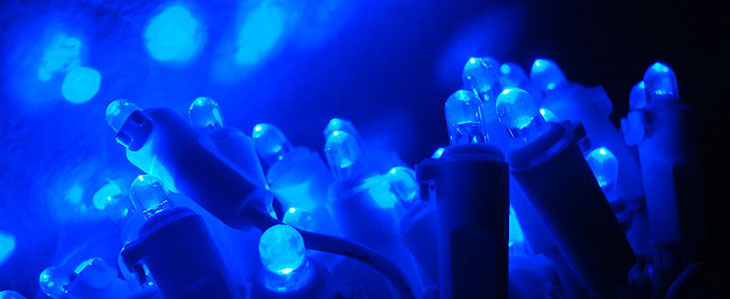Three Scientists Share Physics Nobel Prize For Blue LEDs

Alexofdodd via Wikimedia Commons
(Inside Science) -- The 2014 Nobel Prize in physics has been awarded to two Japanese citizens and one U.S. citizen, all born in Japan, "for the invention of efficient blue light-emitting diodes which has enabled bright and energy-saving white light sources."
The prize goes jointly to Isamu Akasaki of Meijo University in Nagoya, Japan, Hiroshi Amano of Nagoya University in Japan, and Shuji Nakamura of the University of California, Santa Barbara. Starting in the 1990s they produced blue LEDs, an energy-efficient, environmentally friendly source of blue light, which could be mixed with LEDs of other colors to produce what the eye sees as white light.
“I am very honored to receive the Nobel Prize from The Royal Swedish Academy of Science for my invention of the blue LED,” said Nakamura in a statement. “It is very satisfying to see that my dream of LED lighting has become a reality. I hope that energy-efficient LED light bulbs will help reduce energy use and lower the cost of lighting worldwide.”
Red and green LEDs had been around for almost half a century. But without the difficult-to-produce blue LED, which is a shorter wavelength of light, the production of white LED light could not be achieved. When green and red LEDs are combined with blue ones, the result is white light. Or, engineers can aim blue LED light at a material called a phosphor. The collision releases green and red light, which combine with the blue to form white light.
"Years ago I would need to explain what an LED is. Now every kid knows it and every person has it in their cellphone and maybe in their living room lighting," said Christian Wetzel, a professor of physics at the Rensselaer Polytechnic Institute in Troy, New York and a researcher in LEDs.
"I really think that Alfred Nobel would be very happy about this prize. It's really something that will benefit most people," said Per Delsing, chair of the Nobel committee for this year's physics prize. "This is a way to make artificial lighting much more efficient than other, older light sources."
An immense technological challenge as recently as the 1990s, white LEDs are now found ubiquitously as the flashes in cellphone cameras, the screens of smartphones, tablets, laptops, and computer monitors, and in large-screen TVs.
White LEDs are much more energy efficient than traditional incandescent bulbs. While traditional light bulbs convert only a few percent of incoming electrical energy into light, and much of the rest is wasted as heat, current white LED designs convert more than half of electrical energy into light. "More comes out as light than as heat," Wetzel explained.
In addition, white LEDs last longer. Whereas incandescent lights last an average of about 1,000 hours, LEDs can work for 100,000 hours, reducing the need to buy new light bulbs and throw away old ones. And unlike fluorescents, white LEDs do not contain mercury, which can be environmentally toxic in sufficiently large quantities.
The impact of the technology goes beyond lighting and screen displays. Blue LEDs also serve as the basis of blue lasers that can read and write four times as much information on the same-sized optical disk than infrared lasers, because of blue's shorter wavelength. Blu-ray players and video game consoles actually contain lasers that are violet, an even shorter- and more information-dense wavelength, whose development was facilitated by blue LED research. It has helped lead to ultraviolet LEDs, which provide a cheap way to sterilize water, especially in developing nations.
For decades, researchers had identified gallium nitride as a material that could potentially produce blue light very efficiently, but huge technological problems, which seemed insurmountable at times, stood in the way of a practical consumer device.
In the 1980s, Akasaki, an industrial-research veteran, and Amano, a Ph.D. student, collaborated at Nagoya University first to grow gallium nitride crystals of decent quality, by placing them on a sapphire surface coated with a layer of aluminum nitride. Meanwhile, Nakamura, working at Nichia Chemicals, also made progress with gallium nitride.
Building good crystals was not enough. Working LED devices consist of several layers of material. One layer is known as n-type, with n standing for "negative," meaning that there is an excess of electrons. Another layer is called p-type, with p representing "positive," in which there is a shortage of electrons, which can also be considered as positively charged "holes."
Sandwiched between the p- and n-layers is the active layer. When an electrical voltage is applied to the sandwich, it brings together the charged electrons and holes in the active layer, to produce blue light.
Researchers in the 1980s were having difficulty in creating good p-layers with gallium nitride. But accidentally, Akasaki and Amano found that the electron microscopes they used to take pictures of the material were improving the quality of the p-layer. The electrons removed hydrogen that was clogging up the p-layer. Nakamura found that heating the material would also improve the p-layer.
In the 1990s, both teams successfully created increasingly efficient blue LEDs. They experimented with new alloys that include indium and aluminum and the resulting more complex LED sandwiches helped them to become commercially viable.
"So it's very highly integrated, the physics, the materials science and the electrical engineering aspects of it, and only then industry will kick in and manufacture it." Wetzel explained. "It's a success story."
White LEDs can now provide a more efficient source of light for a world in which one-fourth of electricity is consumed for lighting purposes, and can provide lighting through local sources such as solar power for the 1.5 billion people in the world that do not have access to electrical grids. Solar energy during the day can charge batteries that can power lamps at night.
According to Wetzel, by replacing all existing lighting with white LEDs, the U.S. could reduce energy consumption by about 20 percent, equivalent to that produced by the nation's nuclear plants. If electricity use drops, utilities, he said, do not have to put in large investments to build new power plants.
"Of course it goes down the chain in terms of pollution reduction, and greenhouse gas emission savings, and so that's a big impact," Wetzel says.
And this is not the end of the story. Many researchers, including Wetzel, are working to raise the efficiency of LEDs even more, and create LEDs for every color of the spectrum. Completely new concepts are also on the horizon. Miniaturized lighting sources, such as those based on carbon nanotubes -- rolled up single-layer networks of carbon atoms -- could someday succeed semiconductor materials such as gallium nitride and promise even greater efficiency and versatility.

